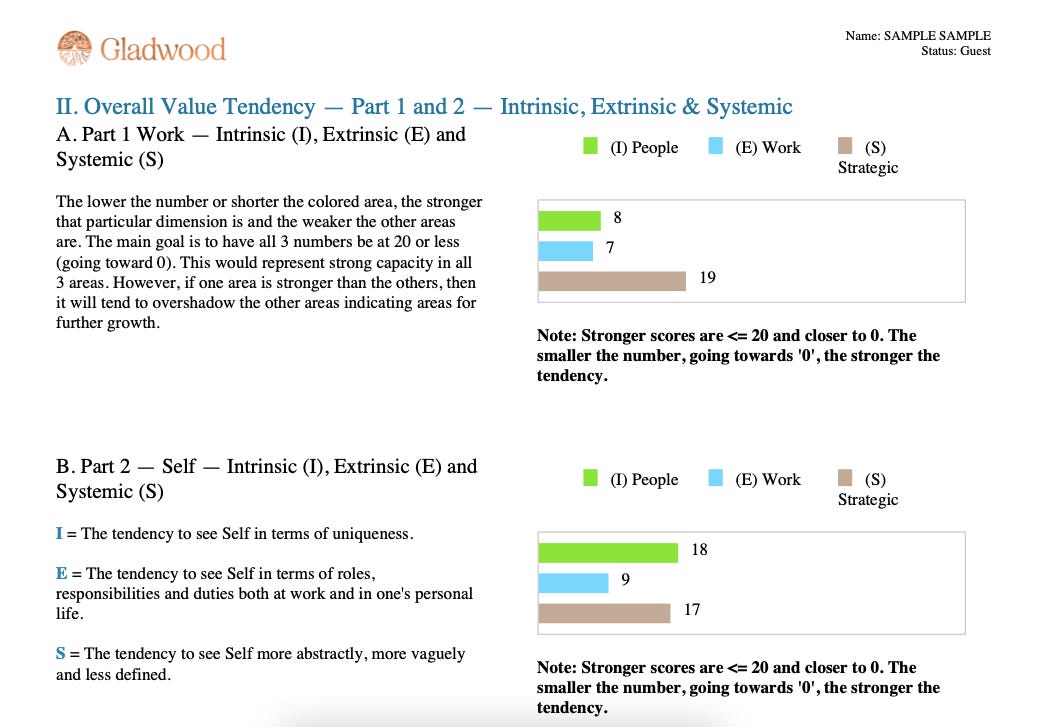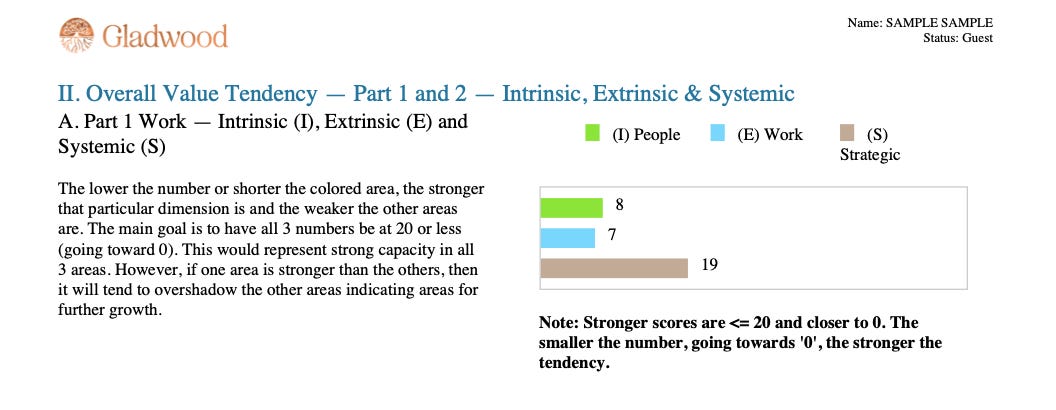Part 1: A Tour of a Hartman Value Profile Report
Terms, Two Parts of the Report and People, Work and Strategy Thinking
As an assessment that measures how we think, how we see things, and how we come up with new ideas and solutions and solve problems, the HVP is an effective tool for creating awareness and getting unstuck from the rut or result that feels impossible to break out of.
It provides information about deeply-rooted belief patterns that impact and dictate our everyday choices and decision making. Since our values dictate thousands of decisions that we make daily, looking into what we think and how we perceive the world (and ourselves) is part of what makes the HVP such a powerful tool for change.
This series is a walk through of a sample HVP report, and we touch on the information in the report that can show us where we are stuck in our thinking and choices. The information creates awareness. With awareness, we can make new choices from a place of greater integrity.
Sometimes just seeing what is true is enough to shift, or start shifting, what we choose to do.
About Value Judgments
Value judgments are the set of beliefs, our individual hierarchy, of what we rank most important to least important, so that as we’re faced with thousands of choices each day, we can make them without spending much time on each decision. Sometimes we don’t think about the decision at all. It’s automatic.
Our set of value judgments are like our decision-making filter system. We take the assessment by ranking a series of statements most positive to least positive–none are right or wrong–that reflect our value judgments.
The report is the result of the information that can be gleaned from our current value judgments, which determine how we perceive and notice information, problem solve, and implement effective solutions.
Since judgment is often used to describe negative behaviors, let’s touch on the definition here. It’s a core part of what we are talking about. The HVP is measuring our potential for good judgment, after all.
About the term “Judgment”
Judgment is our ability to discern wisely and think well. Since it’s normal to use the word judgment to talk about “being judgy” or other negative connotation, discernment can be used in place of the word judgment, if that’s helpful for you.
Judgment is considered in three parts:
Our ability to notice and perceive the information in the world around us
Our ability to be innovative and creative in thinking up solutions and ideas with the information we’ve noticed. Creative problem solving at its finest.
And then our ability to implement the solutions that we consider best.
In the most basic way, our judgment is our ability to be aware of information, to think and problem solve and then to implement the best solutions.
About the Compass Report
In the same way that we might go to a lab and have blood work drawn, and then get different reports back, depending on what kind of testing we’re having done, there’s one HVP assessment, but different types of reports available, depending on what kind of information we want to look at.
The report we’re looking at here is called a Compass Report. It’s created by Dr. Steve Byrum, who studied with Dr. Robert S. Hartman and expanded on Dr. Hartman’s original work to create The Byrum Method. This sample was provided by Renee Wood and Gladwood.
The Report - Overall Judgment Scores
The first part of this report looks at our overall judgment scores. Our strength of judgment directed toward the outside world and our strength of judgment directed internally, toward ourselves. The first part of the report looks like this:
Part 1 Overall Work (or World-side) Judgment:
The first set of measurements, below, measures our strength of judgment in the outside world.
The first bar is the overall measurement for People judgement. It’s about how we think and relate to other people. In the report, it’s formally called Intrinsic judgment.
The second is Work judgment. It’s not just about a career or specific ‘work,’ but about anything we do, from roles and responsibilities, to tasks, to goal-oriented projects. It’s also called Extrinsic judgment on the report.
The third is called Systemic or Strategic judgment. It’s all about understanding the big picture, how we strategically carry out long term goals, and our own clarity about how we live and what drives our decisions and choices.
In the measurements above, the first three bars measure the overall scores for three frameworks–how we think regarding other people, our work and tasks, and our big picture thinking.
It’s helpful to remember – the lower the number of the score, the stronger that score is.
So in the example above, this person’s strongest area of judgment is in thinking about Work and Tasks (the blue bar with a score of 7). The next strongest area is People judgment (the green bar with the score of 8) and the third strongest type of thinking framework is Strategy (the brown bar with the score of 19).
By looking at this part of this sample report, we can tell that this person probably sees most situations, first, from the perspective of Work, asking the question: what needs to be done here?
Scores lower than 20 are considered to be really strong, and reflect good judgment. So in this case, this person is probably quite excellent at figuring out how to clarify the end goal and get the work done.
It could also be helpful for this person to see that the Work and People judgment scores are close together, indicating that they move easily between these mental frameworks. There’s a gap between the first two scores and the third score, which might help them understand that it takes more effort or intention to switch into thinking about long-term planning.
Part 2 - Overall Self-side Judgment:
The second set of bars called Part 2 - Self is almost a repeat of the first set over overall judgment scores, with a twist. These three indicators of People, Work, and Strategy judgment measure our strengths of judgment toward ourselves.
The ability to have good judgment around people, work, and strategy is measured in two parts:
World-side: the way we feel, think, and see the entire world and
Self-side: the way we feel, think, and see ourselves.
Rather than capitulate to our human tendency to compare our report scores to others, the measurements between the World and Self scores provide a more helpful comparison that can point to patterns of integrity or lack of congruence where we may value the outside world differently than we value ourselves.
Noticing where we lack congruence between our inside world and how we think and act in the outside world creates the opportunity to confront our own issues of integrity. With this deeper awareness, we now have the opportunity to step into greater integrity, take ownership for our actions, and create new outcomes in our lives.
On the Self-side:
People judgment is about your sense of knowing yourself–who you are as a unique human being.
Work judgment is about how you see yourself through your roles and responsibilities–what you do in the world.
Strategy judgment is about why you do what you do, and how you fit into the world around you.
Overall, we can see that this person’s strongest sense of himself is who he is in his roles, responsibilities, and work. Next, he knows himself for how he fits into the bigger picture of the world around him, and last, he sees and knows himself for his unique values as an individual.
We can look at these two sets of overall judgment scores and see some tidbits of information that might be helpful:
This person has a strong framework for thinking about getting things done in the world, and a similar sense of seeing themselves through the lens of his roles and responsibilities. There’s a high level of congruence between what he thinks and does internally and what he does in the world.
This person has a really strong sense of valuing other people in the outside world as unique individuals and does not seem to value himself in the same way. This might indicate a lack of congruence between how he relates to others and how he relates to himself. An interesting piece of information in how he thinks, and therefore makes decisions, in his life.
These two sets of overall judgment scores can be used to dive into so many things about how we think–from core leadership styles, to creating teams that are truly diverse in thinking and perspectives, to working with spouses and partners who have different strengths of judgment and styles for thinking about life.
The next three pages of the report dive into each individual measurement of these overall judgment scores. Before we move on to that, here’s an example of how People, Work, and Strategy judgment all fit together and how we move between these frameworks for thinking throughout our day.
Putting People, Work, and Strategy Judgment Together
The experience of flying for travel is an analogy that can be used to understand how we move between types of judgment.
Imagine you arrive at the airport early because you anticipate a long line through security and baggage. You prepare your ticket and ID and as you move through the line and approach the metal detectors, you mentally go through each item in your carry-on, making mental note of what needs to be removed from your luggage when you go through security.
You check the time and make sure you still have a comfortable margin to make it to your gate. This is a Work judgment framework. There’s a task or goal and you’re mentally checking off the steps needed to complete it successfully.
Once you’re through security and your shoes are back on, you decide you have time to grab a coffee and sandwich. As you order, you chat briefly with the individual taking your order, and maybe with the others waiting for coffee, too. You are in People mode.
You have your coffee and now you move back into Work mode. You find your gate, find your priority line, and once you board, find your seat. You know the drill. Carry-on stowed away. Seat up. Buckle fastened. Work mode again.
As the aircraft takes off and gains elevation, your view out of the window begins to change. You see the top of trees, you are eye level with birds. You can see the road that you took to the airport earlier, the garage where you left your car, and even the airport looks small below. You’re in the clouds, and then above them at 30,000 feet.
You can see the big picture, and your perspective might shift to big picture thinking, also. You may dream, mentally zooming to 30,000 feet above your life and considering where you’ve been, where you are, and where you are heading in the future. This 30,000 foot view is the big picture, big vision mode.
When you land, you’re back in Work mode. You need to catch your next flight, and you mentally assess how long you have for your layover and estimate the distance to your gate.
We move through these modes or frameworks for thinking throughout our days. We all use each type of judgment, but usually find one or two most comfortable and assessable.
Understanding our own strengths of judgment can help us appreciate others who approach situations from a different strength of judgment than our own. This also give us the opportunity to determine where we might strengthen our own sense of judgment or collaborate with others who approach situations from a different perspective.
Next Up
We will get into the second page of this report, which dives into the nitty-gritty details of People, Work and Strategy judgment on the World-side.




